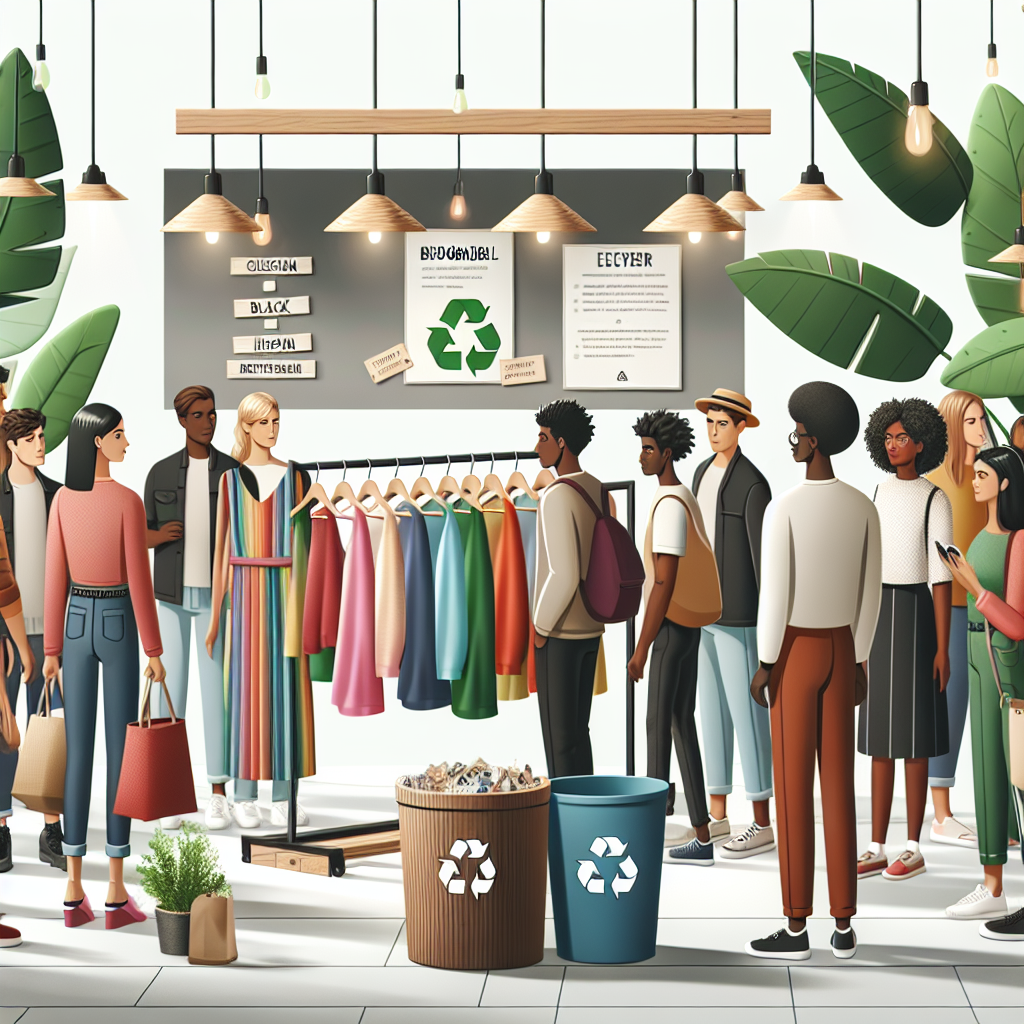Sustainable Fashion: The Move Towards Eco-Friendly Practices
The Rise of Sustainable Materials in Fashion Design
The fashion industry has long been criticized for its negative impact on the environment. From the use of toxic chemicals in production to the excessive waste generated by fast fashion, the industry has been a major contributor to environmental degradation. However, in recent years, there has been a shift towards more sustainable practices in fashion design. This has been driven by a growing awareness of the environmental and social consequences of the industry, as well as consumer demand for eco-friendly products.
One of the key aspects of sustainable fashion is the use of sustainable materials. These are materials that are produced in an environmentally and socially responsible manner, with minimal impact on the planet. This includes materials that are renewable, biodegradable, and non-toxic. The use of sustainable materials in fashion design has been gaining momentum, with more and more designers incorporating them into their collections.
One of the most widely used sustainable materials in fashion is organic cotton. Unlike conventional cotton, which is grown using large amounts of water, pesticides, and fertilizers, organic cotton is grown without the use of harmful chemicals. This not only reduces the environmental impact of cotton production but also ensures the safety and well-being of the farmers who grow it. In addition, organic cotton is biodegradable, making it a more sustainable option compared to synthetic materials.
Another popular sustainable material in fashion is bamboo. Bamboo is a fast-growing plant that requires minimal water and no pesticides to grow. It is also biodegradable and has natural antibacterial properties, making it a great choice for clothing. Bamboo can be used to make a variety of fabrics, including soft and breathable bamboo rayon and durable bamboo linen. It is also a versatile material that can be blended with other fibers, such as organic cotton, to create unique and sustainable fabrics.
In addition to natural materials, there has been a rise in the use of recycled materials in fashion design. This includes recycled polyester, which is made from plastic bottles, and recycled nylon, which is made from discarded fishing nets. These materials not only reduce the amount of waste in landfills but also require less energy and resources to produce compared to virgin materials. They also have the potential to be recycled again, creating a closed-loop system that minimizes the environmental impact of fashion production.
Innovative materials, such as pineapple leather and mushroom leather, have also emerged as sustainable alternatives to traditional leather. These materials are made from natural fibers and are biodegradable, making them a more environmentally friendly option. They also offer a cruelty-free alternative to animal leather, addressing ethical concerns in the fashion industry.
The use of sustainable materials in fashion design not only benefits the environment but also has a positive impact on the communities involved in their production. Many sustainable materials are produced using fair trade practices, ensuring that workers are paid fair wages and have safe working conditions. This promotes social responsibility and empowers communities, particularly in developing countries where many fashion materials are sourced.
In conclusion, the rise of sustainable materials in fashion design is a positive step towards a more eco-friendly and ethical industry. By choosing sustainable materials, designers can reduce their environmental footprint and promote social responsibility. As consumers become more conscious of the impact of their fashion choices, the demand for sustainable materials will continue to grow, driving the industry towards a more sustainable future. It is up to designers and brands to embrace these materials and lead the way towards a more sustainable and responsible fashion industry.
How Ethical Production is Changing the Fashion Industry

The fashion industry has long been criticized for its negative impact on the environment and its unethical production practices. From the use of harmful chemicals in textile production to the exploitation of workers in developing countries, the fashion industry has a long way to go in terms of sustainability and ethical practices. However, in recent years, there has been a shift towards more eco-friendly and ethical production methods in the fashion industry.
One of the main reasons for this shift is the growing awareness and concern about the environmental and social impact of the fashion industry. With the rise of fast fashion, where clothing is produced at a rapid pace and sold at low prices, the amount of waste and pollution generated has increased significantly. According to the Environmental Protection Agency, the fashion industry is the second-largest polluter in the world, just behind the oil industry. This alarming statistic has led to a call for change and a move towards more sustainable practices.
One of the key ways in which the fashion industry is becoming more sustainable is through the use of eco-friendly materials. Traditional textile production involves the use of harmful chemicals, such as pesticides and dyes, which not only pollute the environment but also pose health risks to workers. However, there has been a rise in the use of organic and sustainable materials, such as organic cotton, bamboo, and recycled polyester. These materials are grown and produced without the use of harmful chemicals, making them better for the environment and the health of workers.
In addition to using eco-friendly materials, the fashion industry is also embracing circular fashion. This concept involves designing and producing clothing with the intention of keeping them in use for as long as possible. This means using durable materials and designing garments that can be easily repaired or recycled. This approach not only reduces waste but also encourages consumers to buy fewer, higher-quality pieces that will last longer.
Another aspect of sustainable fashion is ethical production practices. The fashion industry has long been criticized for its exploitation of workers, particularly in developing countries where labor laws are often lax. However, there has been a push for fair labor practices and better working conditions in the fashion industry. Many brands are now working with factories that provide fair wages and safe working conditions for their employees. In addition, there has been a rise in the use of certifications, such as Fair Trade and B Corp, which ensure that workers are treated ethically and fairly.
Moreover, the fashion industry is also making efforts to reduce its carbon footprint. The production and transportation of clothing contribute significantly to greenhouse gas emissions. To combat this, many brands are implementing sustainable supply chain practices, such as using renewable energy sources and reducing the distance between production and distribution centers. Some brands are even using carbon offsetting programs to neutralize their carbon emissions.
The move towards sustainable and ethical fashion is not just limited to production practices but also extends to the end of a garment’s life cycle. Many brands are now offering take-back programs where customers can return their old clothing to be recycled or repurposed. This not only reduces waste but also encourages consumers to think about the lifespan of their clothing and the impact of their choices.
In conclusion, the fashion industry is slowly but surely moving towards more sustainable and ethical practices. From the use of eco-friendly materials to fair labor practices and reducing carbon emissions, the industry is making strides towards a more responsible and environmentally friendly future. However, there is still a long way to go, and it is up to both brands and consumers to continue pushing for change and making more conscious choices when it comes to fashion. By supporting sustainable and ethical fashion, we can all contribute to a better and more sustainable world.
The Impact of Fast Fashion on the Environment and the Push for Sustainable Alternatives
In recent years, the fashion industry has come under scrutiny for its negative impact on the environment. The rise of fast fashion, a business model that focuses on producing cheap and trendy clothing at a rapid pace, has led to a significant increase in waste and pollution. As consumers become more aware of the consequences of their shopping habits, there has been a push for sustainable alternatives in the fashion industry.
The term “fast fashion” refers to the quick turnover of clothing collections, with new styles being introduced every few weeks. This model has been adopted by many popular brands, making it easier and more affordable for consumers to constantly update their wardrobes. However, this constant demand for new clothing has led to a massive increase in production, resulting in a significant strain on the environment.
One of the main issues with fast fashion is the excessive use of natural resources. The production of clothing requires large amounts of water, energy, and raw materials. According to the United Nations Environment Programme, the fashion industry is responsible for 20% of global wastewater and 10% of carbon emissions. This not only contributes to climate change but also has a devastating impact on local ecosystems.
Moreover, the production of synthetic fabrics, such as polyester and nylon, releases microplastics into the environment. These tiny particles can take hundreds of years to decompose and are often ingested by marine life, causing harm to the ecosystem. In addition, the use of toxic chemicals in the dyeing and finishing process of clothing has led to water pollution and health hazards for workers in the industry.
The negative impact of fast fashion goes beyond the production stage. The constant disposal of clothing also contributes to the growing issue of textile waste. In the United States alone, over 11 million tons of clothing end up in landfills each year. These clothes take up valuable space and release harmful greenhouse gases as they decompose. Furthermore, the majority of these clothes are made from synthetic materials, making them difficult to recycle.
As consumers become more aware of these issues, there has been a growing demand for sustainable and eco-friendly fashion. This has led to the rise of sustainable fashion brands that prioritize ethical and environmentally friendly practices. These brands use organic and recycled materials, reduce their carbon footprint, and promote fair labor practices.
In addition to sustainable brands, there has also been a shift towards circular fashion. This concept focuses on creating a closed-loop system where clothing is designed to be reused, recycled, or repurposed. This not only reduces waste but also extends the lifespan of clothing, reducing the need for constant production.
The push for sustainable fashion has also been driven by consumers’ changing attitudes towards shopping. With the rise of social media and influencer culture, there has been a shift towards conscious consumerism. People are now more interested in the story behind their clothes and the impact of their purchases. This has led to a rise in the popularity of second-hand and vintage clothing, as well as the trend of “renting” clothes for special occasions.
In conclusion, the fashion industry’s fast fashion model has had a significant negative impact on the environment. The excessive use of resources, pollution, and textile waste have led to a growing demand for sustainable alternatives. As consumers become more conscious of their shopping habits, the fashion industry is slowly shifting towards more eco-friendly practices. However, it is essential for both brands and consumers to continue pushing for change and making sustainable fashion the norm rather than the exception.











